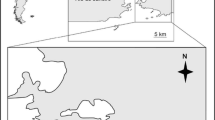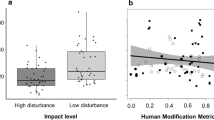Abstract
Ghost crabs are distributed worldwide on sandy beaches, and several studies have associated the number of ghost crab burrows with the levels of anthropogenic impacts on the beaches under study. However, our results show that the use of ghost crab Ocypode quadrata burrows to assess levels of anthropogenic impacts on sand beaches may not be accurate, as previously thought, because the number of burrows does not represent an estimate of the population size. In addition, we propose three hypotheses to explain the extremely low number of individuals/number of burrows ratio: the “secret chamber”, the “multiple openings”, and the “one crab, several burrows” hypotheses. We also observed an unusual sex ratio.
Similar content being viewed by others
References
Melo G.A.S., Manual for the identification of the Brachyura (crabs) from the Brazilian coast [Manual de identificação dos Brachyura (caranguejos e siris) do litoral brasileiro], 1st ed., Plêiade, São Paulo, 1996 (in Portuguese)
Lerman M., Marine biology: environment, diversity, and ecology, Benjamin/Cummings, California, 1986
Alberto R.M.F., Fontoura N.F., Distribution and age structure of Ocypode quadrata (Fabricius, 1787) (Crustacea, Decapoda, Ocypodidae) in a sandy beach in the south coast of Brazil [Distribuição e estrutura etária de Ocypode quadrata (Fabricius, 1787) (Crustacea, Decapoda, Ocypodidae) em praia arenosa do litoral sul do Brasil], Rev. Bras. Biol., 1999, 59, 95–108 (in Portuguese)
Chan B.K.K., Chan K.K.Y., Leung P.C.M., Burrow architecture of the ghost crab Ocypode ceratophthalma on a sandy shore in Hong Kong, Hydrobiologia, 2006, 560, 43–49
Chakrabarti A., Burrow patterns of Ocypode ceratophthalma (Pallas) and their environmental significance, J. Paleontol., 1981, 55, 431–441.
Turra A., Gonçalves M.A.O., Denadai M.R., Spatial distribution of the ghost crab Ocypode quadrata in low-energy tide-dominated sandy beaches, J. Nat. Hist., 2005, 39, 2163–2177.
Hill G.W., Hunter R.E., Burrows of the ghost crab Ocypode quadrata (Fabricius) on the Barrier Islands, South-Central Texas coast, J. Sediment. Petrol., 1973, 43, 24–30
Shuchman E., Warburg M.R., Dispersal, population structure and burrow shape of Ocypode cursor, Mar. Biol., 1978, 49, 255–263
Yong A.Y.P., Lim S.S.L., The potential of Ocypode ceratophthalmus (Pallas, 1772) as a bioindicator of human disturbance on Singapore beaches, Crustaceana, 2009, 82, 1579–1597
Wolcott T.G., Ecological role of ghost crabs, Ocypode quadrata (Fabricius) on an ocean beach: scavengers or predators?, J. Exp. Mar. Biol. Ecol., 1978, 31, 67–82
Valero-Pacheco E., Alvarez F., Abarca-Arenas L.G., Escobar M., Population density and activity pattern of the ghost crab, Ocypode quadrata, in Veracruz, Mexico, Crustaceana, 2007, 80, 313–325
Barros F., Ghost crabs as a tool for rapid assessment of human impacts on exposed sandy beaches, Biol. Conserv., 2001, 97, 399–404
Blankensteyn A., Use of the maria-farinha crab Ocypode quadrata (Fabricius) (Crustacea, Ocypodidae) as indicator of the anthropogenic impacts on sandy beaches of Ilha de Santa Catarina, Brazil [O uso do caranguejo mariafarinha Ocypode quadrata (Fabricius) (Crustacea, Ocypodidae) como indicador de impactos antropogênicos em praias arenosas da Ilha de Santa Catarina, Santa Catarina, Brasil], Rev. Bras. Zool., 2006, 23, 870–876 (in Portuguese)
Schlacher T.A., Thompson L., Price S., Vehicles versus conservation of invertebrates on sandy beaches: mortalities inflicted by off-road vehicles on ghost crabs, Mar. Ecol., 2007, 28, 354–367
Noriega R., Smeuninx B., Ghost crab (Ocypode cordimanus) as a potential indicator of human impact along Gold Coast beaches, Griffith Cent. Coast. Manag. Res. Rep., 2008, 82, 1–36
Peterson C.H., Hickerson D.H.M., Johnson G.G., Short-term consequences of nourishment and bulldozing on the dominant large invertebrates of a sandy beach, J. Coastal Res., 2000, 16, 368–378
Araujo C.C.V., Rosa D.M., Fernandes J.M., Density and spatial distribution of the crab Ocypode quadrata in three sandy beaches of EspÍrito Santo, Brazil [Densidade e distribuição espacial do caranguejo Ocypode quadrata (Fabricius, 1787) (Crustacea, Ocypodidae) em três praias arenosas do Espírito Santo, Brasil], Biotemas, 2008, 21, 73–80 (in Portuguese)
Hobbs C.H. III, Landry C.B., Perry J.E. III, Assessing anthropogenic and natural impacts on ghost crabs (Ocypode quadrata) at Cape Hatteras National Seashore, North Carolina, J. Coastal Res., 2008, 24, 1450–1458
Souza J.R.B., Lavoie N., Bonifacio, P.H., Rocha, C.C., Distribution of Ocypode quadrata (Fabricius, 1787) on sandy beaches of northeastern Brazil, Atlântica, 2008, 30, 139–145
Lucrezi S., Schlacher T.A., Robinson W., Human disturbance as a cause of bias in ecological indicators for sandy beaches: experimental evidence for the effects of human trampling on ghost crabs (Ocypode spp.), Ecol. Indic., 2009, 9, 913–921
Silva W.T.A.F., Calado T.C.S., Spatial distribution of and anthropogenic impacts on ghost crab Ocypode quadrata (Crustacea: Ocypodidae) burrows in Maceió, Brazil, Rev. Nord. Zool., 2011, 5, 1–9
Hughes D.A., On mating and the “copulation burrows” of crabs of the genus Ocypode (Decapoda, Brachyura), Crustaceana, 1973, 24, 72–76
Christy J.H., Burrow structure and use in the sand fiddler crab, Uca pugilator (Bosc), Anim. Behav., 1982, 30, 687–694
Warren J.H., The use of open burrows to estimate abundance of intertidal estuarine crabs, Aust. J. Ecol., 1990, 15, 277–280
Macia A., Quincardete I., Paula J., A comparison of alternative methods for estimating population density of the fiddler crab Uca annulipes at Saco Mangrove, Inhaca Island (Mozambique), Hydrobiologia, 2001, 449, 213–219
Skov M.W., Hartnoll R.G., Comparative suitability of binocular observation, burrow counting and excavation for the quantification of the mangrove fiddler crab Uca annulipes (H. Milne Edwards), Hydrobiologia, 2001, 449, 201–212
Barrass, R., The burrows of Ocypode ceratophthalmus (Pallas) (Crustacea, Ocypodidae) on a tidal wave beach at Inhaca Island, Moçambique, J. Anim. Ecol., 1963, 32, 73–85
Negreiros-Fransozo M.L., Fransozo A., Bertini G., Reproductive cycle and recruitment period of Ocypode quadrata (Decapoda, Ocypodidae) at a sandy beach in southeastern Brazil, J. Crustacean Biol., 2002, 22, 157–161
Haley S.R., Relative growth and sexual maturity of the Texas ghost crab, Ocypode quadrata (Fabr.) (Brachyura, Ocypodidae), Crustaceana, 1969, 17, 285–297
Strachan P.H., Smith R.C., Hamilton D.A.B., Taylor A.C., Atkinson R.J.A., Studies on the ecology and behaviour of the ghost crab, Ocypode cursor (L.) in northern Cyprus, Sci. Mar., 1999, 63, 51–60
Author information
Authors and Affiliations
Corresponding author
About this article
Cite this article
Silva, W.T.A.F., Calado, T.C.S. Number of ghost crab burrows does not correspond to population size. cent.eur.j.biol. 8, 843–847 (2013). https://doi.org/10.2478/s11535-013-0208-7
Received:
Accepted:
Published:
Issue Date:
DOI: https://doi.org/10.2478/s11535-013-0208-7




